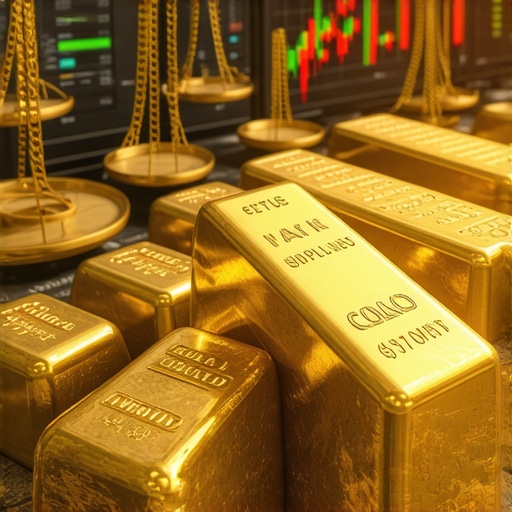Unveiling the Complex Interplay Between Global Economic Dynamics and Gold Valuation in 2025
The trajectory of gold prices in 2025 is intricately woven into the fabric of prevailing global economic trends. As an expert in financial markets and precious metals, I recognize that understanding these macroeconomic forces offers invaluable insights for investors, policymakers, and industry insiders alike. This article explores the nuanced mechanisms through which economic shifts, geopolitical developments, and monetary policies will influence gold’s valuation over the coming year.
The Role of Macroeconomic Indicators in Shaping Gold Prices
Fundamental economic indicators such as inflation rates, GDP growth, and unemployment figures serve as vital signals for gold market participants. Historically, rising inflation—particularly when coupled with low interest rates—has bolstered gold’s appeal as a hedge. Conversely, robust economic growth often diminishes its allure, as investors shift towards risk assets. In 2025, the delicate balance between these indicators will determine whether gold acts as a safe haven or a risk asset, with market analysis suggesting increased volatility amidst economic transitions.
Impact of Central Bank Policies and Gold Accumulation Strategies
Central banks worldwide continue to influence gold prices through their purchase and reserve management strategies. Notably, the central bank gold purchases forecasted for 2025, as detailed in market outlook reports, reflect a strategic shift towards gold accumulation amid geopolitical tensions and currency uncertainties. These policies often serve as a counterbalance to currency devaluation, reinforcing gold’s status as a reserve asset. Analyzing these trends provides a deeper understanding of future price trajectories.
Geopolitical Tensions and Economic Uncertainty as Catalysts
Geopolitical developments—such as trade disputes, conflicts, and diplomatic tensions—have historically driven gold prices upward during periods of heightened uncertainty. In 2025, ongoing geopolitical shifts are expected to create a backdrop of instability, prompting safe-haven demand. Such factors underscore the importance of monitoring global political landscapes, as they often cause sharp fluctuations in gold valuations, emphasizing the need for sophisticated risk management strategies.
How Will Technological and Market Innovations Influence Gold Pricing?
Emerging financial instruments, including gold-backed cryptocurrencies and innovative derivatives, are transforming the trading landscape. These technological advances facilitate greater market accessibility and liquidity, potentially amplifying price movements. For investors seeking to capitalize on these developments, effective techniques such as technical analysis of gold futures are critical, as discussed in market strategy guides. Staying ahead of these innovations requires a nuanced understanding of both traditional fundamentals and cutting-edge market dynamics.
What are the most complex challenges in predicting gold prices amidst changing global economic conditions?
Predicting gold prices in 2025 involves navigating a labyrinth of intertwined factors, including unpredictable geopolitical shifts, monetary policy uncertainties, and technological disruptions. These elements create a complex environment where models must account for non-linear interactions and emergent phenomena. As such, continuous analysis of supply-demand cycles, reserve trends, and macroeconomic indicators is essential for making informed investment decisions. For a comprehensive approach, consider developing a diversified gold portfolio that includes physical assets, ETFs, and strategic futures trading, as explored in diversification strategies.
To deepen your expertise, explore our advanced investment techniques and contribute your insights to the evolving discourse on gold market dynamics.
Deciphering the Complex Web of Geopolitical and Technological Influences on Gold in 2025
As a seasoned analyst in precious metals markets, I recognize that the interplay between geopolitical developments and technological advancements is reshaping the landscape of gold investing. In 2025, investors must navigate a terrain marked by unpredictable international tensions and rapid innovations in financial technology, which together influence gold’s role as a safe haven and investment asset.
The Geopolitical Catalyst: Navigating Uncertainty and Market Sentiment
Geopolitical tensions—ranging from trade wars and diplomatic conflicts to regional instability—historically serve as powerful catalysts for gold price surges. The ongoing global power struggles and territorial disputes are likely to persist into 2025, amplifying demand for gold as a hedge against geopolitical risk. Market participants should pay close attention to developments in regions such as Eastern Europe, the South China Sea, and the Middle East, as these areas continue to influence global stability and investor confidence.
For a detailed analysis of how such tensions are expected to influence future prices, refer to emerging demand factors. Understanding these dynamics enables investors to anticipate market shifts and adjust their portfolios accordingly, integrating physical assets, ETFs, or futures strategies to optimize safety and growth.
Technological Disruption: Redefining Gold Market Accessibility and Liquidity
Technological innovations—such as blockchain-based gold-backed cryptocurrencies and digital trading platforms—are revolutionizing how investors access and trade gold. These tools improve transparency, reduce transaction costs, and expand market participation, which could lead to increased volatility but also greater liquidity in gold markets. As highlighted in market strategy guides, mastering these new instruments requires not only traditional analysis but also a deep understanding of digital asset mechanics and market structure.
Adopting advanced technical analysis techniques, such as analyzing gold futures’ price patterns and volume indicators, can help traders capitalize on these innovations. The integration of artificial intelligence and machine learning algorithms into trading platforms offers new opportunities for predictive analytics, but also demands a nuanced grasp of market signals and risk management techniques.
Are current geopolitical tensions and technological trends creating a new paradigm for gold investment that we have yet to fully understand?
This question pushes investors to think beyond conventional wisdom, considering how emergent factors might fundamentally alter gold’s function in portfolios. As noted by experts, such as those from market analysis reports, a comprehensive approach involves monitoring supply-demand cycles, reserve management policies, and global economic indicators alongside technological developments.
For those eager to deepen their expertise, exploring strategies such as diversifying holdings with gold ETFs, physical assets, and futures trading can help you build a resilient portfolio. Also, consider reading more about advanced investment strategies that blend traditional fundamentals with cutting-edge tools for market success. Your insights and questions are invaluable—share your thoughts or ask for tailored advice to navigate this evolving landscape effectively.
Deciphering the Impact of Monetary Policy Divergence on Gold Dynamics in 2025
In 2025, the divergence in monetary policies among major economies—particularly between the Federal Reserve, the European Central Bank, and the People’s Bank of China—will likely create a complex landscape for gold investors. Central banks’ varying stances on interest rates, quantitative easing, and reserve management directly influence gold’s appeal as a hedge against inflation and currency devaluation. For instance, a tightening cycle in the US coupled with easing in other regions could lead to increased demand for gold as a safe haven, while simultaneous rate hikes might suppress its short-term gains. According to a report by the International Monetary Fund (IMF), such policy divergence can induce heightened volatility, demanding sophisticated risk management strategies for investors.
The Role of Digital Currencies and Blockchain Innovations in Gold Market Evolution
As blockchain technology matures, its integration into gold trading platforms is reshaping market accessibility and transparency. Digital gold tokens backed by physical assets offer new liquidity channels, enabling fractional ownership and 24/7 trading—features previously limited to traditional markets. This technological leap not only broadens investor participation but also introduces new price discovery mechanisms, potentially leading to increased market efficiency or volatility. Experts from Blockchain Research Lab highlight that the convergence of digital currencies with physical gold assets could redefine the risk-return profile, making it imperative for investors to understand blockchain mechanics and regulatory landscapes.
Exploring the Intricate Nexus of Global Policy Shifts and Gold Valuation Tactics
As we delve deeper into 2025’s gold market landscape, it becomes evident that geopolitical maneuvering and monetary policy divergence are not merely background noise but pivotal forces shaping investor sentiment and price trajectories. The nuanced interplay between regional conflicts, international diplomacy, and central bank strategies demands a sophisticated analytical framework that incorporates geopolitical risk indices, macroeconomic indicators, and forward-looking policy forecasts. This multi-layered approach enables market participants to anticipate shifts with higher precision and craft resilient investment strategies.
The Impact of Digital Transformation on Gold Trading Ecosystems
Emerging blockchain-based platforms and tokenized gold assets are revolutionizing traditional trading paradigms, enhancing transparency, reducing transaction costs, and democratizing access. These technological advancements facilitate fractional ownership, 24/7 market operations, and real-time settlement—features that significantly alter liquidity and volatility profiles. Investors must now develop expertise in blockchain mechanics, smart contract security, and regulatory compliance to leverage these innovations effectively, transforming their approach from conventional to cutting-edge asset management.

How Do Diverging Monetary Policies Amplify Gold’s Safe-Haven Appeal in a Complex Global Economy?
The divergence in interest rate policies among the Federal Reserve, ECB, and PBOC creates a volatile environment that can either bolster or suppress gold prices depending on the directional flow of capital. When the US tightens monetary policy while other regions ease, gold often experiences increased demand as a hedge against dollar strength and inflationary pressures. Conversely, synchronized rate hikes across major economies may dampen gold’s appeal in the short term. Analyzing these policy paths alongside currency reserve shifts provides a comprehensive picture for strategic positioning, as highlighted by recent IMF reports emphasizing the importance of dynamic risk assessment models.
Can Technological Innovations Be the Catalyst for a New Gold Market Equilibrium?
Blockchain integration, digital gold tokens, and AI-driven trading algorithms are not only enhancing market efficiency but also introducing new layers of complexity. These tools enable rapid response to market signals but require sophisticated understanding of digital asset mechanics, cybersecurity, and evolving regulatory landscapes. Mastery of these domains allows investors to capitalize on arbitrage opportunities and hedge against emerging risks, transforming the traditional gold investment paradigm into an ecosystem of innovation-driven resilience.
Expert Insights & Advanced Considerations
1. Geopolitical tensions will continue to be a pivotal driver of gold prices, necessitating investors to monitor regional conflicts and diplomatic developments for strategic positioning.
Historical patterns demonstrate that instability in regions like Eastern Europe and the Middle East correlates with surges in gold demand, emphasizing the importance of geopolitical risk assessment in 2025.
2. Technological innovations such as blockchain-based gold tokens and AI-driven trading platforms are transforming market liquidity and transparency, requiring investors to develop expertise in digital asset mechanics.
Understanding these tools enables more agile and informed decision-making, especially as digital gold trading expands global participation and introduces new volatility patterns.
3. Diverging monetary policies among major economies will heighten volatility, with shifts in interest rates and reserve management influencing gold’s safe-haven appeal.
Monitoring central bank actions and currency reserve flows will be essential in navigating these complex dynamics to optimize investment outcomes.
4. The integration of digital currencies with physical gold assets is creating new liquidity channels and price discovery mechanisms, warranting a sophisticated grasp of blockchain and regulatory environments.
Investors should stay informed about regulatory developments and technological trends to leverage these innovations effectively.
5. Supply-demand cycles, central bank reserve strategies, and macroeconomic indicators must be analyzed in tandem to develop resilient, diversified gold portfolios capable of withstanding market shocks.
This comprehensive approach ensures alignment with emerging market realities and enhances long-term wealth preservation.
Curated Expert Resources
- Market Analysis Reports: Deep dives into macroeconomic and geopolitical factors shaping gold prices, available at gold market analysis 2025.
- Blockchain and Digital Asset Platforms: Insights into blockchain technology’s impact on gold trading from Blockchain Research Lab.
- Central Bank Reserve Strategies: Detailed reports on reserve management and central bank gold purchases at central bank gold outlook 2025.
- Economic Policy Divergence Analysis: Expert evaluations of monetary policy impacts on gold, accessible via global economic analysis 2025.
Final Expert Perspective
In 2025, understanding the multifaceted forces that influence gold price dynamics—ranging from geopolitical tensions and technological innovations to monetary policy divergence—is essential for sophisticated investors. By integrating comprehensive resource insights with strategic vigilance, you can position your portfolio to navigate volatility and capitalize on emerging opportunities. Engage deeply with these analyses, share your insights, or explore tailored strategies to stay ahead in this evolving landscape, ensuring your wealth preservation efforts remain robust and adaptive.










